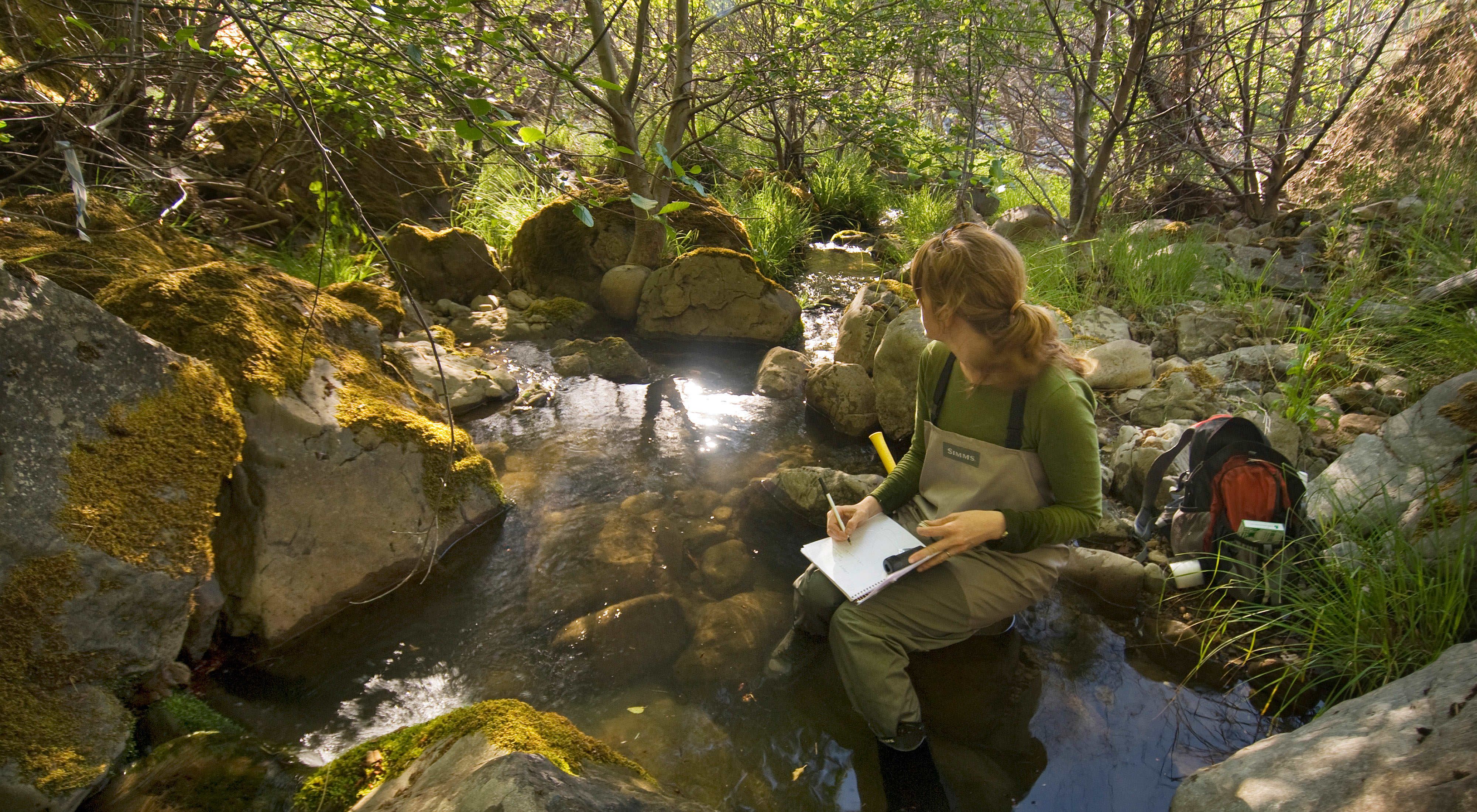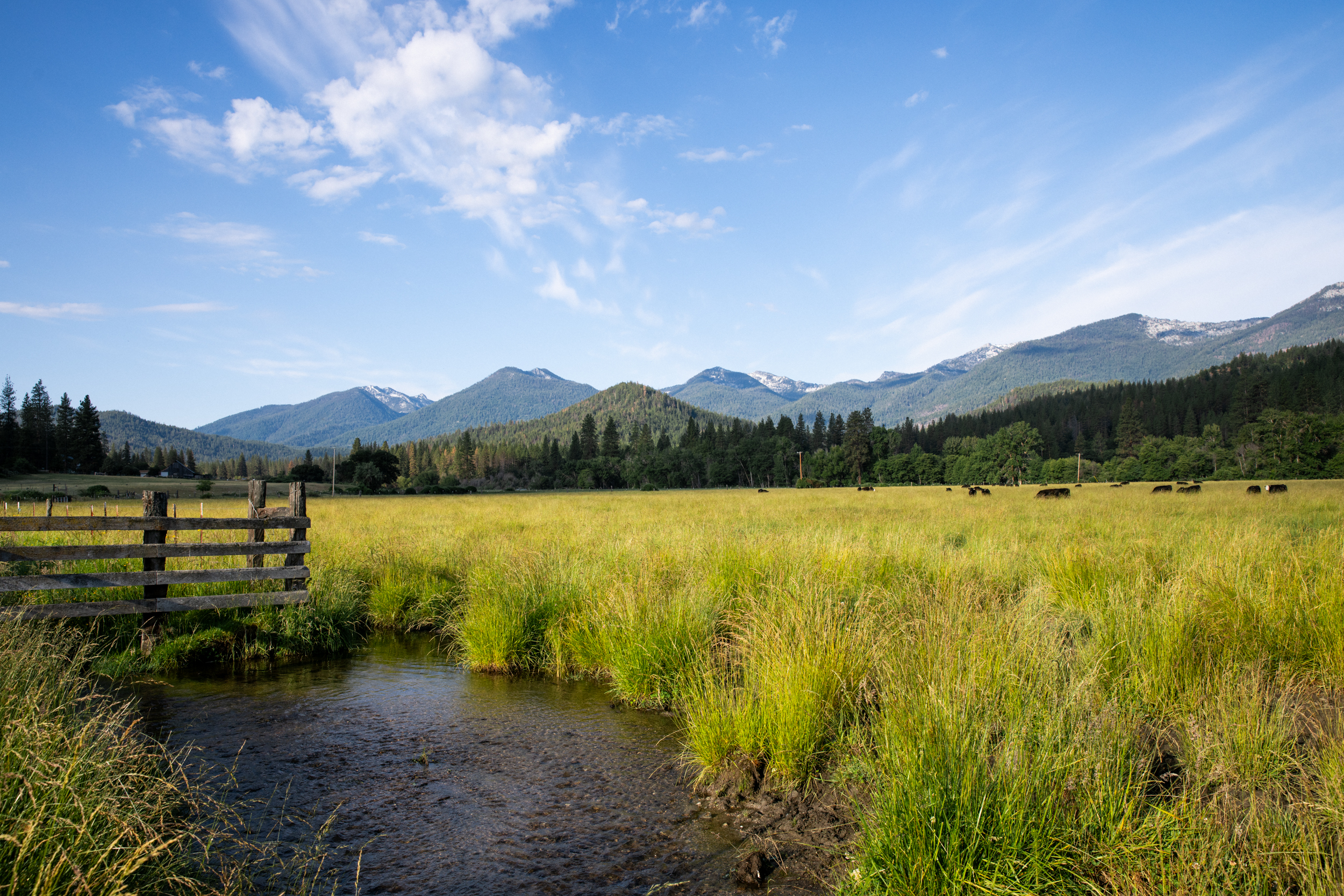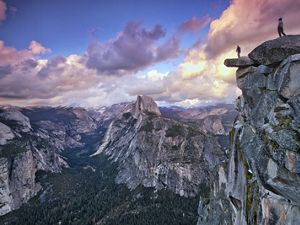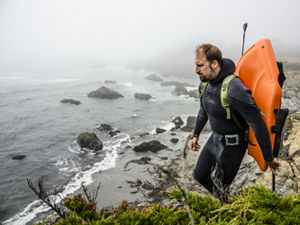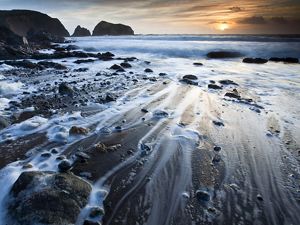Climate Stories
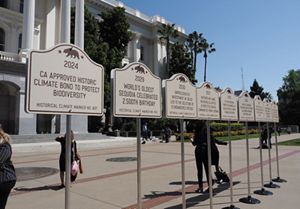




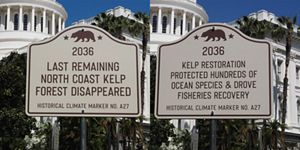

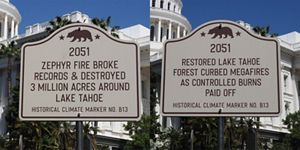



Two Future Californias: These double-sided signs show two futures: one where California invests in nature-based climate solutions, and one where nature is left behind. © Autumn Leiker

2024: California’s 2024 climate bond could be a lifeline for native species throughout our state. © Autumn Leiker

2029: Megafires have already threatened some of California’s biggest and oldest trees. Without ecological forest restoration, we could lose our sequoias for good. © Autumn Leiker

2030: The initiative to protect 30% of California’s natural lands by 2030 (30x30) has the potential to curb climate impacts and protect endangered species. © Autumn Leiker

2031: Wetlands have the power to insulate our coasts from storm surges and provide habitat for wildlife. But without wetlands, our coasts are vulnerable to severe flooding. © Autumn Leiker

2036: Kelp forests provide habitat for over 1,000 marine species, but these ecosystems are disappearing from California’s North Coast. With direct action, we can restore them. © Autumn Leiker

2050: Freeways and transportation infrastructure have cut mountain lions off from their historical habitat. But they shouldn’t have to risk a car collision to find food and mates. © Autumn Leiker

2051: Sierra forests evolved with fire, and controlled burns are critical to keeping them healthy. If CA invests in controlled burns, we can protect our forests from catastrophe. © Autumn Leiker

2055: Salmon are a bellwether for the health of our rivers. If there is no water for salmon, it’s only a matter of time until there is no water for us. © Autumn Leiker

2063: The rivers California relies on are in danger of running dry if we don’t change the way we manage our water. © Autumn Leiker
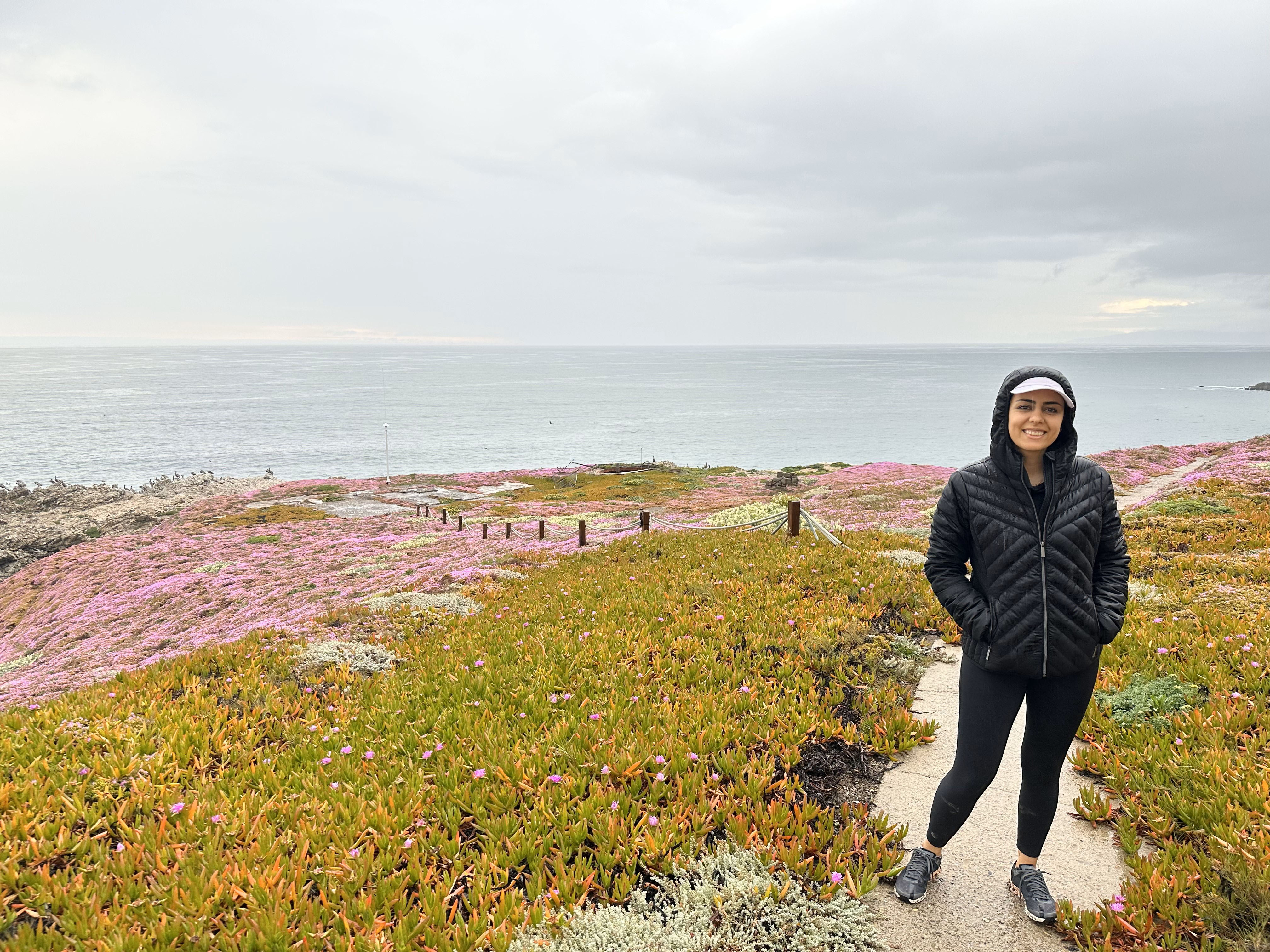
October 22, 2024
From Flow to Flame: Linking Hydroclimatic Changes to Wildfire Risk
By Mahsa Khodaee, Spatial Data Analyst at TNC's Point Conception Institute (PCI)
The threat of catastrophic wildfires is a persistent concern, especially in California, where shifts in climate patterns significantly impact ecosystems, creating conditions that heighten wildfire risks and alter fire behavior. Despite progress in understanding these dynamics, applying scientific knowledge to real-world solutions remains challenging. The Point Conception Institute (PCI) aims to bridge this gap by combining rigorous scientific research with actionable, on-the-ground conservation strategies. This approach allows PCI to play a crucial role in translating data-driven insights into effective management practices, making it a key player in regional conservation efforts.
As a Spatial Data Analyst at PCI, I leveraged geospatial analysis to study the interplay between climate shifts, water resources, and wildfire risk. My passion for this work comes from a deep interest in the ecohydrological processes of forested ecosystems, a focus that guided my Ph.D. research. My time at PCI enabled me to build on this expertise to develop insights and tools that support prescribed burn planning and risk reduction at the Jack and Laura Dangermond Preserve (JLDP). This role provided valuable opportunities, allowing me to apply my academic background to real-world challenges and collaborate closely with other scientists and land managers.
My role involved integrating climate trends from hydrometeorological data into wildfire models, addressing the need to understand how extreme weather events shape wildfire risk. While droughts are known to elevate risks, the impacts of rapid vegetation growth, heavy rainfall, and subsurface water are less understood. Even in data-rich California, significant knowledge gaps persist due to the complexity of these interactions and limited historical records. Our work aimed to address these gaps by studying how long-term shifts, like changes in groundwater recharge, affect fire probabilities. We aim to transform these findings into practical tools—interactive maps and applications—that help land managers make informed decisions about risk reduction.
Advancing our understanding of climate impacts is essential for building resilience, closely aligning with PCI’s mission to drive effective conservation. The regional wildfire risk analysis and insights we developed offer critical information for strategic decision-making and targeted risk reduction efforts.
See the full paper here.
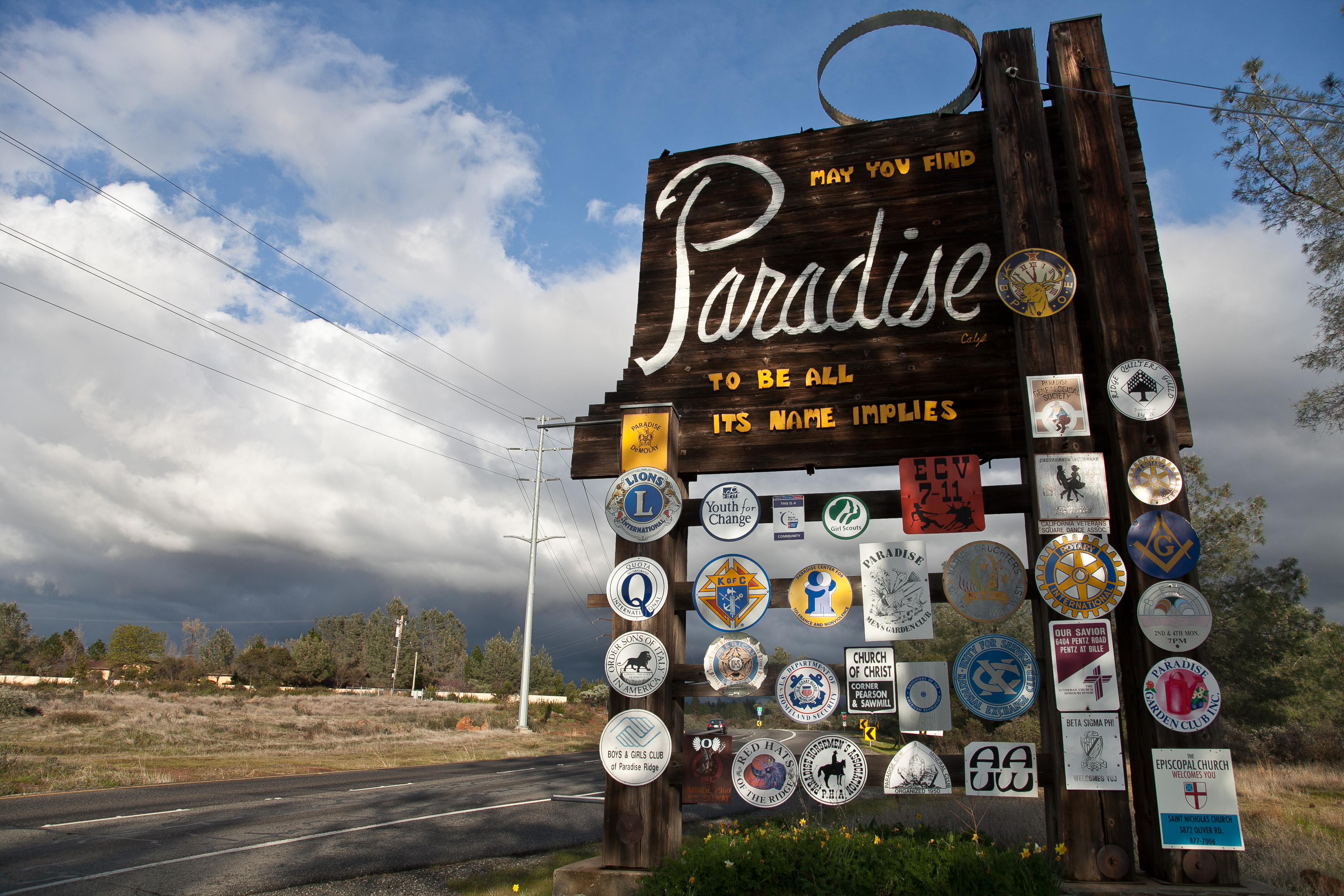
"Nature-based solutions will be a big part of the future we are building."
Paradise Protected
The catastrophic Camp Fire still looms large in California’s collective consciousness. But the town of Paradise is working with TNC to make sure that the destruction it faced in 2018 never happens again.
As the region rebuilds, we’ve teamed up with the Paradise Recreation & Park District to reduce the risk of future wildfires. To do this, we’re implementing a nature-based climate solution that is as good for nature as it is for people: open space buffers.
An open space buffer is a natural area, like a park or recreation area, that provides a transitional zone between wildlands and urban spaces. When houses and human infrastructure butt up against our forests, wildfires can quickly spread to communities, and catastrophes like the Camp Fire become more common. Open space buffers act as fire breaks, slowing down or even stopping fires by creating space between the forest and the town.
We’ve already seen evidence of this strategy working in Paradise. During the Camp Fire, many residents took shelter at Bille Park when they couldn’t leave by road. The fire burned right up to the edge of the park but not into it.
Paradise Recreation & Park District recognized the importance of this open space and reached out to TNC to explore ways to replicate it in the new city plan. Together, we asked three questions:
- What if the park had been sited to reduce fire risk?
- How could we save even more lives?
- Could we pair the benefits for people with outcomes for nature?
The answers we found have changed the way Paradise will rebuild.
With support from the Federal Emergency Management Agency (FEMA), the insurance firm Marsh McLennan and multiple other partners, we studied how fire risk in Paradise would change under different scenarios. What would happen if, instead of rebuilding on every parcel of land, the community used plots next to the forest to construct open space buffers?
We settled on a scenario that would reduce fire risk up to 64%: a long buffer strategically positioned on the eastern edge of the town. Paradise’s recent General Plan adopted our strategy, codifying this science-based approach through 2030 and providing a legal foundation upon which all land-use decisions will be based.
Over the next few years, we’ll be working to acquire the individual parcels to incorporate into the buffer, and we’ve already received donations of land in key locations within the project’s target area. As Californians, we are going to need to learn to live with fire. Nature-based solutions will be a big part of the future we are building.

December 15, 2022
Wins for Our Forests
A Season of Close Calls
As the 2022 wildfire season draws to a close, we are reflecting on how precarious our relationship with fire in California has become. On September 6th, the Mosquito Fire raged up the American River Canyon, forcing our colleagues to evacuate their homes. Over the next eight weeks, Foresthill was saved by firefighters twice and flames came within six aerial miles of TNC’s French Meadows Project, 28,000 acres of forest at various stages of restoration.
Now, we are doubling down on our efforts to stem the cycle of destructive wildfires while setting the stage for a future where fire restores our forests instead of destroying them. This work is both ambitious and complex, but we are happy to report that your support has allowed TNC to lead the way for California forest restoration.
Public Sector Wins
TNC’s Let’s Stop Making History campaign helped change the broader public narrative, moving away from “all fire is bad” and toward a story based on facts centered on the importance of “good fire” to restore our forests and prevent megafires. The campaign was aimed at lawmakers, and the awareness it built catalyzed a massive surge in wildfire resilience funding, including nearly $3 billion of state funding and $7.5 billion in federal funding.
Behind the scenes, TNC scientists were working with the Forest Service and leading academic researchers to develop a prioritization framework to direct restoration funding to a 2.4 million-acre landscape of high-priority forest around Lake Tahoe. Recently, this Framework for Resilience was adopted by California’s Natural Resources Agency, which has partnered with Google.org to make the tool easy to use and freely available to state programs and all fire practitioners in California. The resulting interface, Planscape, will go live in early 2023 and will help direct billions of dollars.
Private Sector Wins
A MARKET FOR RESTORATION BYPRODUCTS: Much of the new funding for forest restoration will be used for “ecological thinning,” the removal of small and unhealthy trees and brush that spread megafires. This creates a lot of low-value wood material, so our team partnered with Bain & Company to find a market for it. We created a new $49 million-dollar Revolving Loan Program, administered by California’s Investment Bank, designed to help landowners reinvest proceeds from these new wood products in forest restoration.
INSURANCE: Lack of liability insurance for private prescribed fire practitioners is a key barrier to increasing controlled burns. In 2022, our team worked to establish a $20 million Prescribed Fire Claims Fund pilot, which will serve as a backstop to the private insurance market for public benefit controlled burning. To design the fund, we partnered with Senator Bill Dodd and others to develop and secure the passage of a companion bill, Senate Bill 926.
What’s Next
ON THE GROUND: Now, TNC is launching a massive controlled burning training initiative. With initial seed funding from CAL FIRE, we’re creating our own in-house fire team that will train more than 1,200 conservation fire practitioners by 2025, significantly increasing our state’s capacity for controlled burns.
ON CAPITOL HILL: We are working to pass significant policy reforms at the federal level. The National Prescribed Fire Act (S.1734 Sens Wyden, Manchin, Cantwell, Feinstein) would approve $600 million for controlled burns on federally managed lands and require agencies to increase the area treated with controlled burns. In 2022, despite broad support for this bill, Congress did not act. But with growing awareness of the problem, we are hopeful the 118th Congress will take up the bill. Stay tuned in 2023.

October 17, 2022
Where Infrastructure Meets Conservation
It can be amazing to watch organizations with so many different missions come together to achieve a shared goal. At the Regional Conservation Investment Strategy (RCIS) Symposium, that goal was to integrate conservation into infrastructure planning.
TNC sponsored the legislation that created RCISs five years ago. The aim was to get transportation, water and energy agencies to design projects that avoid impacting sensitive species and habitats, while restoring and protecting larger, connected landscapes. The program has already resulted in eight approved strategies with three more currently in development. That means 11 million acres in California will receive conservation-minded transportation infrastructure. But where do we go from here?
On September 20th, 2022 we held our fourth annual RCIS Symposium where 200 attendees, panelists and speakers came together to share information and best practices on the Regional Conservation Investment Strategy.
Highlights from the day:
- California Department of Fish and Wildlife Director Chuck Bonham kicked off the event by reflecting on the push to integrate community and nature values and amplify conservation priorities that guide decisions.
- East Kaweah (Tulare County) RCIS, discussed how the program has enabled difficult stakeholder engagement, connecting conservation and agriculture with the Sustainable Groundwater Management Act.
- Assemblymember Rebecca Bauer-Kahan, Natural Resources Agency Deputy Secretary Jennifer Norris and TNC’s Jay Ziegler engaged in a conversation on how RCIS strategies help regions meet climate resilience, water, infrastructure, and housing goals, with special attention to conservation and nature-based solutions.
For infrastructure agencies, locating and protecting sensitive species and habitats reduces risks to infrastructure projects that result in faster project approvals and an increase of community support. When infrastructure agencies invest in conservation, to help achieve their business and community goals, nature wins.
August 18, 2022
All Aboard for Community Conservation
Southeast of San Jose lies the Diablo Mountain Range, home to mountain lion, bobcat, badger and tule elk. The Range is renowned for its biodiverse chaparral communities that provide refuge for plants and animals against high-intensity fires, making it one of the last remaining places resilient to the effects of climate change within the Bay Area. Alongside local partners, TNC protected the Diablo Range using strategic conservation tools like land acquisitions, watershed and rangeland management and most recently, advance mitigation, working with infrastructure agencies to reduce impacts before projects are implemented.
Pacheco Pass, which bisects the Diablo Range, is a migratory route for both wildlife and people between the Central Valley and the Bay Area. But US Route 152 acts as a barrier to local wildlife, fragmenting habitat and putting native species at risk. More than 10 years ago, the California High-Speed Rail Authority selected Pacheco Pass to connect the Bay Area and the Central Valley, so TNC and our partners made sure we could influence the planning to protect this critical habitat.
Now, After seven years of community engagement, including the creation of the Pajaro Compass, the High-Speed Rail Authority has committed to building a wildlife crossing over Route 152, providing safe passage for at-risk species.
This is an extraordinary milestone, but the train has not yet left the station. Alongside our partners at the Peninsula Open Space Trust, Santa Clara Valley Open Space Authority and the Santa Clara Valley Habitat Agency, we will continue to fight for climate resilience in the region, because all the species of the Bay Area (including us!) rely on the Diablo Range.
Land Stories
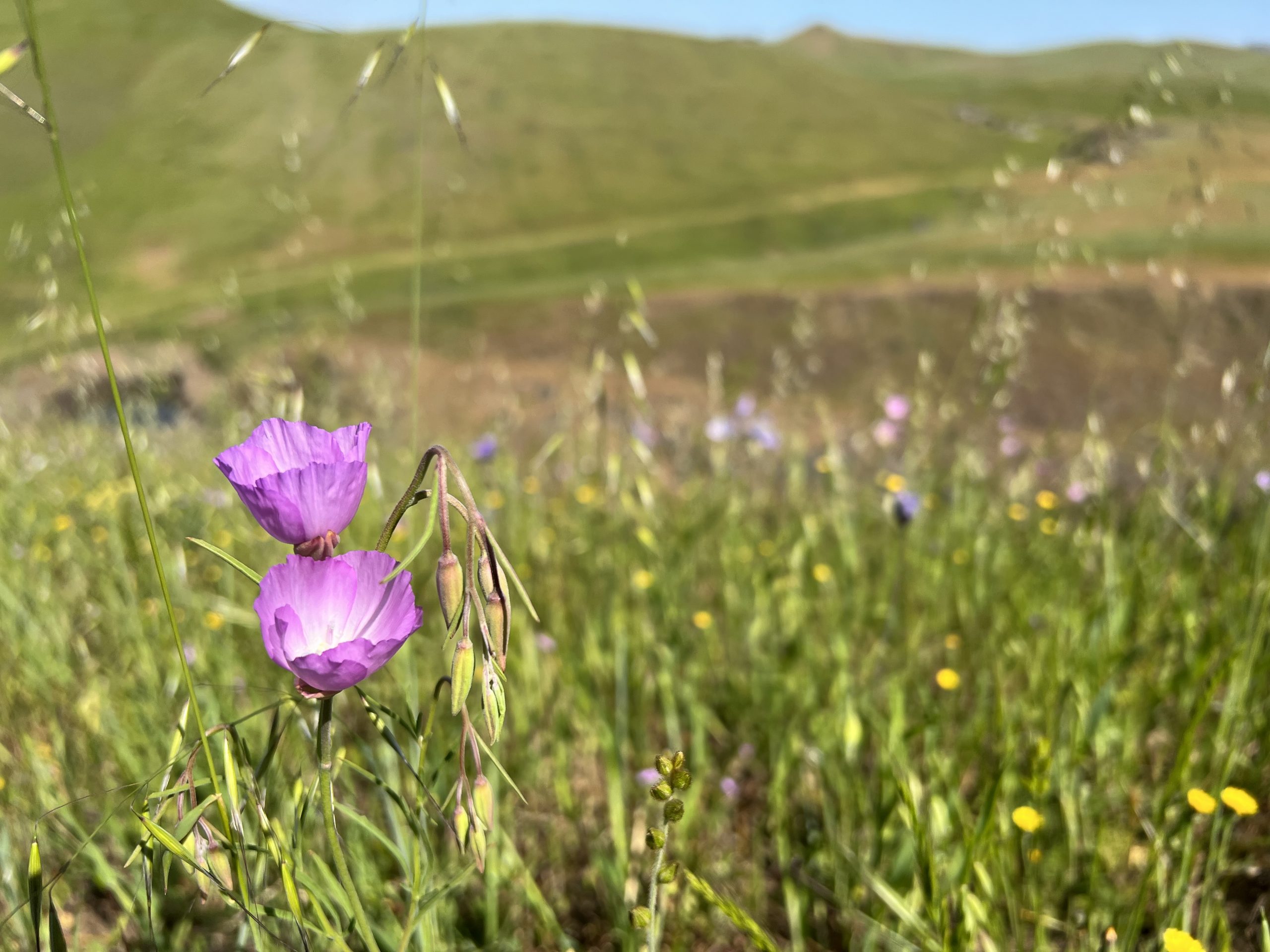
Waltz-Turner Ranch
The Nature Conservancy has just successfully completed an ambitious strategy to protect nearly 40,000 acres of high priority land in California. Waltz-Turner Ranch—one of the largest, most connected, climate-resilient and biodiverse properties in the state—is now under a conservation easement that protects it for generations to come.
Filled with expansive oak woodlands, rolling grasslands and vernal pools, the ranch is home to black bear, mountain lion, bobcat, badger, and threatened and endangered species including Swainson’s Hawk and California tiger salamander. In conjunction with the newly protected Camatta Ranch in San Luis Obispo, Waltz-Turner Ranch helps to create a continuous corridor of open space from the San Joaquin Valley to the Sierra Nevada crest and into Yosemite National Park.
Protecting these two ranches is the result of a multi-year, highly strategic effort by TNC, The Land Conservancy of San Luis Obispo County and Sierra Foothill Conservancy (SFC). In 2022, this coalition stepped in when a corporate entity was poised to market Waltz-Turner Ranch for public sale. TNC was able to act swiftly and decisively to close the deal and acquire the ranch, thanks in large part to the Quick Strike Protection Fund and Acquisition Reserve made possible by our supporters.
TNC’s strategy was to acquire the ranch and ensure that meaningful protections were put in place before entrusting its long-term maintenance to the local ranching family and SFC land trust, who have a deep connection to the land. We are grateful for their partnership.
The protection of Waltz-Turner Ranch and its subsequent return to the stewardship of the family that has been on the land for generations, now opens up both financial and staffing resources for TNC to pursue new high-impact initiatives. It’s work like this that forwards our critical mission to create a connected network of wildlands that spans California to ensure that native species can thrive.
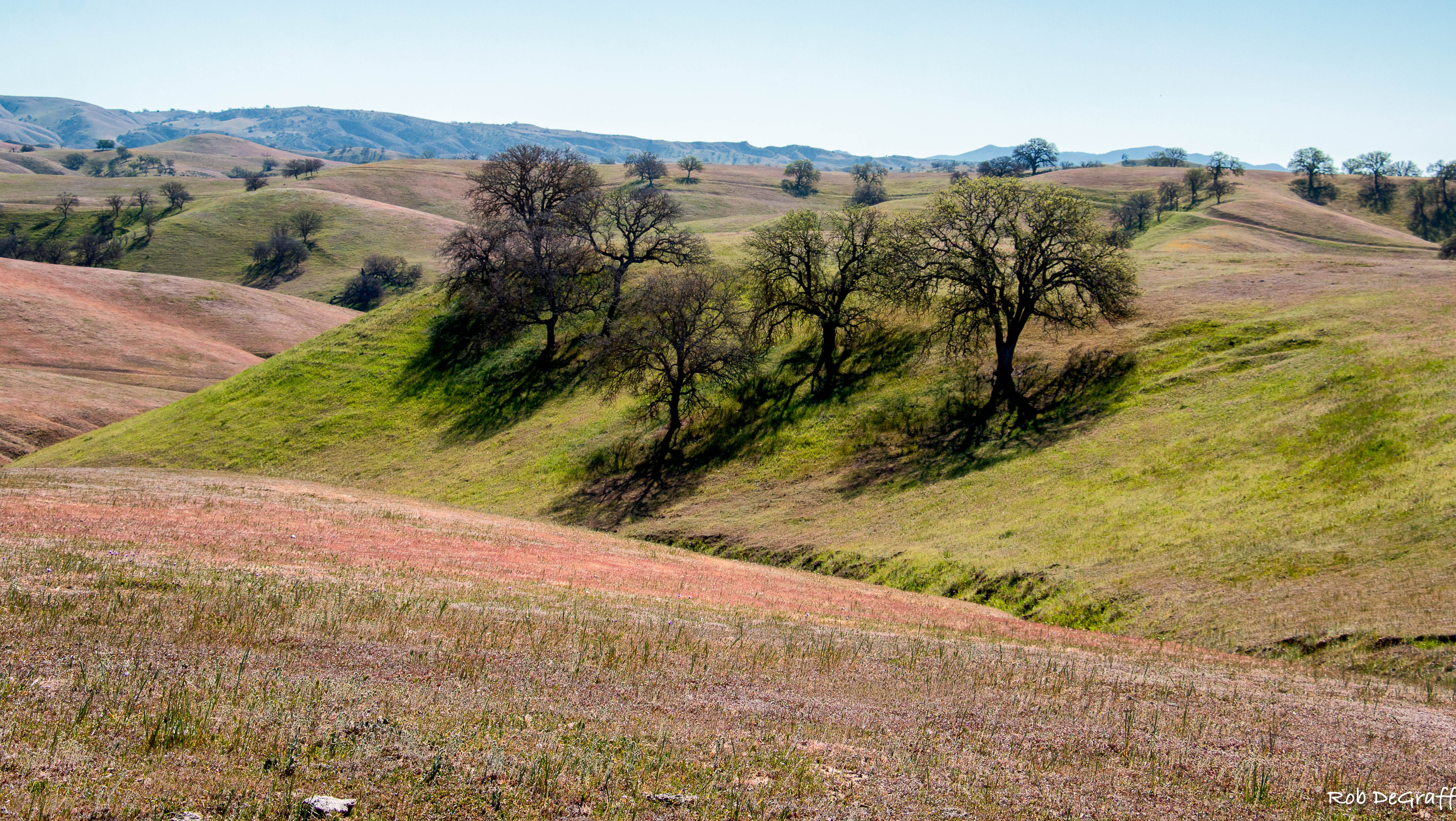
June 4, 2024
A Legacy for Ranchers and Nature
TNC helped secure a historic conservation easement at Camatta Ranch in San Luis Obispo, protecting over 27,000 acres of blue oak woodlands, grasslands and chaparral. We were part of an amazing coalition that worked in close partnership with the Morrison family, who’ve ranched these lands for generations. A conservation easement is a voluntary agreement between landowners and a land trust to maintain the unique ecological values and open space character of the property, which remains in effect even if the land is sold or passed on within the family.
The Morrison family approached The Land Conservancy of San Luis Obispo (LCSLO) in 2019, hoping to find an alternative to partitioning off or selling the ranch. Instead, they wanted to preserve both their family’s multi-generational legacy and the vast, connected wildlands (an area roughly the size of San Francisco). With the help of LCSLO and partners including TNC, LegacyWorks Group and multiple state agencies, that dream became a reality.
“This easement means being able to continue working the ranch, cultivating it, being here, living on it and then passing it on to future generations. This was a make-or-break opportunity for the ranch,” said Haustin Morrison. “This property is [going to] be here way past me and my family. Our time here is short, but this property is protected forever.”
Camatta Ranch provides critical habitat for wildlife including pronghorn antelope, San Joaquin kit fox and California condor. Located in the largely unprotected Inner Coast Range, the ranch was a high-priority geography for TNC to protect because of its significant role in our strategic effort to create landscape connections for wildlife across California. With the easement in place, we’re proud to leave the management of the property in the trusted hands of The Land Conservancy of San Luis Obispo and turn our focus towards the next high-impact opportunity to make sure nature has a place in California’s future.
Learn more about the Camatta Ranch easement in this article from the Paso Robles Daily News.
Rewilding California: Release the Tadpoles!




This spring, red-legged frogs found a new home in Southern California, thanks to a conservation victory many years—and miles—in the making. Once common across the Western United States and Mexico, red-legged frogs had completely disappeared from Southern California and Northern Baja. But in 2021, TNC led an international coalition to reintroduce this critical species to the region.
From an initial transplant of just five egg masses (each consisting of over 500 eggs) that were carried painstakingly by helicopter and car from Baja, we’re now reintroducing as many as 30 egg masses at a time, and our project just expanded to a new pond. Existing red-legged frog populations are thriving, a success that makes this increase possible.
Get the full story on Notes from the Field, where we go behind the scenes as red-legged frog eggs travel from Mexico to California. Find out how these amphibians help native species thrive while protecting us from disease.
Skunk watch!
Check out island spotted skunks in action on Santa Cruz Island! More than 1,000 species of plants and animals inhabit this Southern California island, including 12 species found nowhere else on Earth.





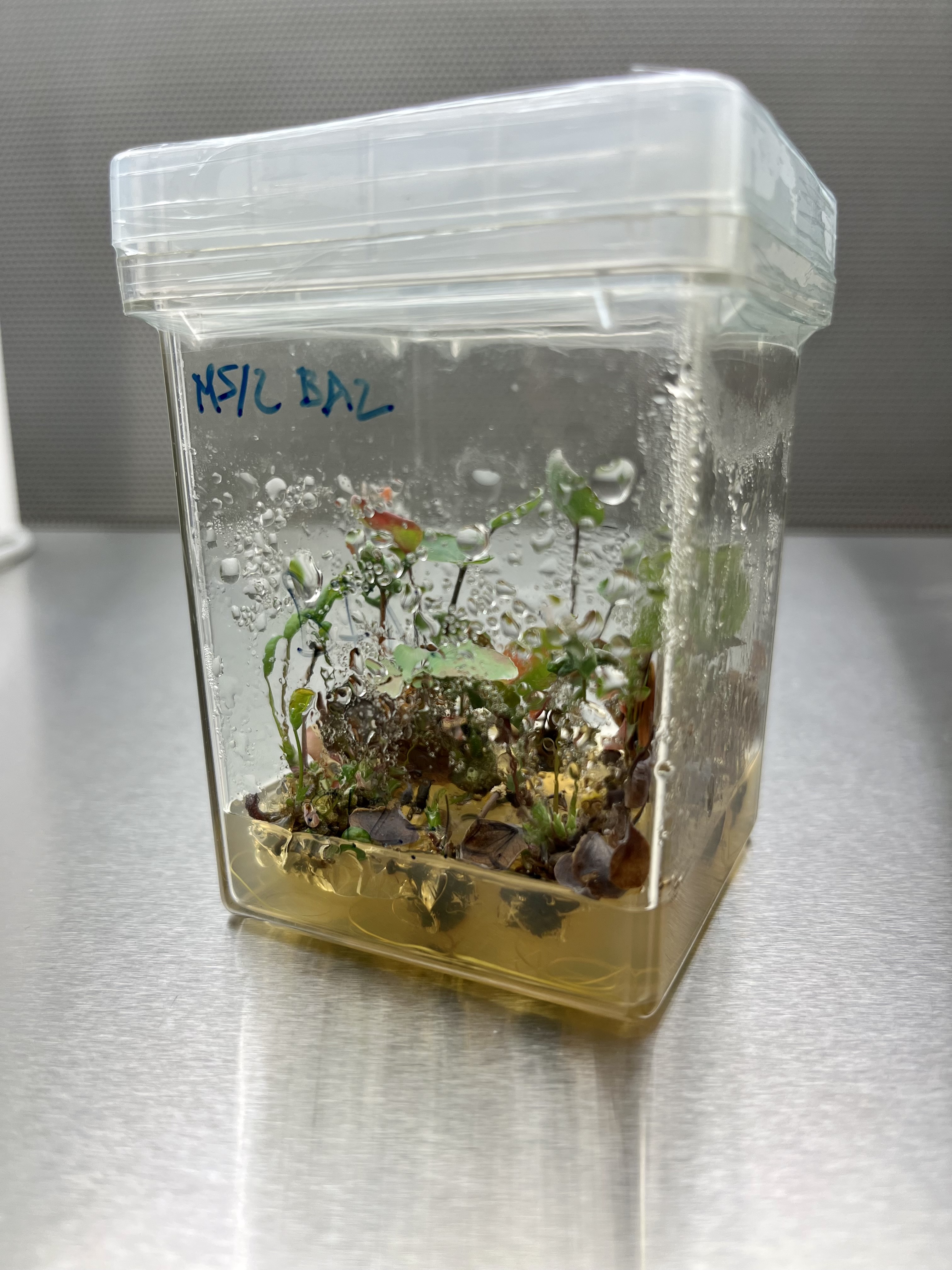
December 8, 2022
Native Plants REMOVED from the Endangered Species List!
Something amazing happened on Santa Cruz Island. Two rare plants on the verge of extinction have made a comeback. Historically, few plants have ever come off the Endangered Species List but on the Channel Islands, we’re showing that recovery is possible.
The Trouble with Islands
Compared to the mainland, islands have fewer species, so each one needs to take on a bigger workload as part of the ecosystem. From providing food for pollinators to soil remediation and creating habitat for other species, native flora keep islands running. But the more plants islands lose the harder it is for their ecosystems to defend against threats like invasive species and climate change. These two recently delisted species are only found on the islands.
Archipelago Power!
Santa Cruz Island is one of a chain of islands stretching from Baja California del Sur, all the way up our coast. Because each island is stewarded by a different group, and it can be hard to break silos…until now. Island stewards and botanists from each of the California islands formed a group to work on plant recovery across the archipelago. Together, we share expertise, remove invasive species that threaten native flora, fundraise together, and leverage our unique skills for the health of every island. Now, this partnership is, quite literally, bearing fruit.
What’s next?
Thanks to our collective efforts, more and more plants are poised to come off the endangered species list on islands up and down our coast. But climate change is making our work harder and there is A LOT to do. In partnerships with institutions like the Santa Barbara, Huntington, and California Botanic Gardens, we’re restoring highly endangered species like Island Barberry on Santa Cruz Island, which has only 11 individuals remaining on earth!
On our islands, each species is part of an intricate puzzle and, one by one, we’re putting the pieces back together.

October 25, 2022
Remembering a Conservation Hero
This October, a light in the world went out. We lost Dawit Zeleke, a friend to all who knew him and one of the most effective advocates for nature TNC has ever known. As a farmer and a fierce conservationist, Dawit was able to turn divides between conservation and agriculture into strong bonds and shared goals.
Over the arc of his extraordinary career, Dawit led conservation partnerships across California, and he was doing this work up until the moment he left us. He was integral to the protection of the wetlands of the Cosumnes River, he helped establish new forests along the Sacramento River and he saw through the 20-year Hamilton City Project.
Dawit led the effort to make TNC’s Staten Island a model for sustainable, wildlife friendly agriculture and reduced emissions farming. Additionally, he curated the Sierra Valley Preserve to be a haven for both people and wildlife, down to the Visitor Center’s “bird-proof glass.” Dawit was with The Nature Conservancy in California for 30 years.
Beyond his conservation legacy, Dawit was a wonderful person. His infectious spirit and luminous smile made him a natural connector, but his deep belief in the people in his life made him a true friend.
To honor Dawit, we’ve established the Dawit Zeleke Memorial Fund to support independent projects at the intersection of conservation and agriculture.
The Secret Lives of Animals
We’ve gathered a selection of wildlife camera images that give us glimpses into the secret lives of animals at our preserves. In California, we use these cameras to monitor native species and gain insights into how they interact. But at the same time, they help us watch for invasive species that could disrupt delicate ecosystems.
Learn More!

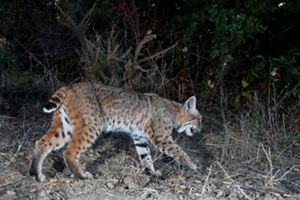
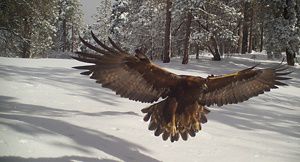
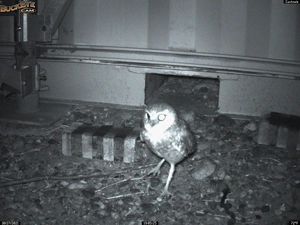
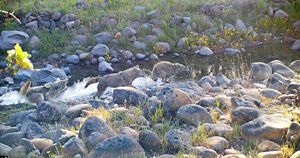
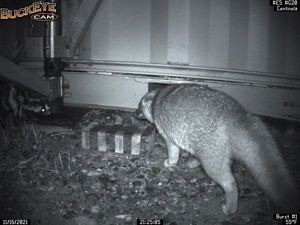
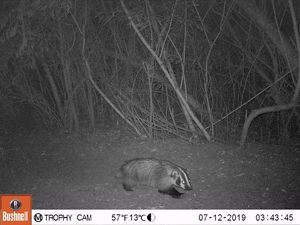
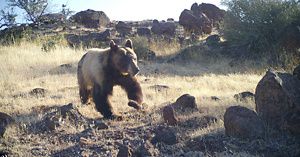
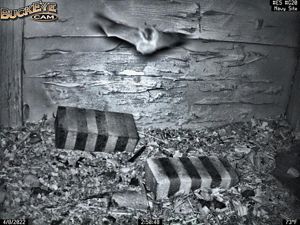

Fox vs. Mouse: An island fox makes quick work of an island deer mouse on Santa Cruz Island. © TNC/Scott Meyler/Juli Matos/Lara Brenner

Shrike: An Island Loggerhead Shrike feeds its fledgling a juicy beetle. © TNC/Scott Meyler/Juli Matos/volunteer Roland Sosa

Bobcat: A bobcat creeps along a path at the Dangermond Preserve. © TNC / John Stuelpnagel

Golden Eagle: A golden eagle near the top of Bear Mountain, Randall Preserve. © TNC / Gregory Warrick

Burrowing Owl: A burrowing owl using a Conex box as a burrow on Santa Cruz Island. © TNC/Scott Meyler/Juli Matos/Lara Brenner

Coyotes: Coyotes chase one another through a seasonal creek. © TNC / Scott Hardage

Island Fox and Spotted Skunk: An island fox and island spotted skunk encounter on Santa Cruz Island. © TNC/Scott Meyler/Juli Matos/Lara Brenner

Badger: An elusive badger shows himself at the Hanson preserve in Santa Paula, CA © TNC/Kat Selm/staff volunteer Wyatt Harris

Black Bear: This black bear is about to descend into the Dye Creek canyon before the summer day heats up. © TNC / Scott Hardage

Bat: A bat (species unknown) spreading its wings on Santa Cruz Island © TNC/Scott Meyler/Juli Matos/Lara Brenner

Acquiring Frog Lake and Carpenter Ridge - July 2, 2020
Giving Bears, Deer, Mountain Lions Room to Roam
When the railroad first came through the Sierra Nevada in the 1800s, the government divided the forest into a checkerboard of square-mile parcels. Many of these were given to the Union Pacific Railroad Company in exchange for laying track, and ultimately sold off one by one. This long game of checkers split up habitat for generations of wildlife, and TNC and our partners have worked for decades to reconnect the land.
In June of 2020, we had a major win in a series of linked land acquisitions. Through the Northern Sierra Partnership, TNC assisted a local land trust in acquiring the 680-acre Frog Lake property, a spectacular wild landscape nestled in a glaciated bowl below the Sierra Crest. Earlier this spring we helped the partners acquire 2,240 acres of forested lands known as Carpenter Ridge and Red Mountain, a steep ridgeline that insulates the fens and meadows of the protected Carpenter Valley.
Together, these connected lands provide habitat for imperiled species like the willow flycatcher and the gray wolf, which recently ventured back into California for the first time in a century. The area is home to other wide-ranging mammals like black bears, mountain lions, and mule deer. By protecting the slopes that surround Carpenter Valley, we’re not only conserving essential habitat, we’re securing the health of a watershed that hundreds of thousands of people rely on.
These acquisitions are a major milestone in reconnecting wildlife habitat in the Northern Sierra. The deal also opens once-private property for public recreation, so that people and nature can enjoy this pristine landscape for generations to come. Read about this historic acquisition in The Mercury News.

March 26, 2020
Protecting Land and Water in the Lassen Foothills
In March 2020, TNC acquired the 462-acre Nobmann Ranch in the Lassen Foothills. This beautiful property abuts our Dye Creek Preserve, connecting habitat for the state’s largest migratory deer herd and protecting Mill Creek, a haven for at-risk species like Chinook salmon and steelhead. Mill Creek has the highest elevation Chinook spawning grounds in North America. Salmon travel more than 300 miles from the ocean to reach their destination near Lassen National Park. Thanks to this acquisition, TNC has become one of the largest holders of water rights in the Mill Creek system. The property comes with an impressive water right of three cubic feet-per-second, the equivalent of three basketballs worth of water going by every second, 24 hours a day.
Mill Creek is fed by the cold, volcanic springs of the Cascade mountain Range, which makes it highly resistant to drought, unlike other rivers that rely on rain and snowmelt. We plan to bolster the health of the Mill Creek system and keep the stream flowing for salmon year-round by using our portfolio of water rights to deliver the water nature needs. With this work we are creating a model that can be replicated across the state to help California’s freshwater species thrive.
Now, the Nobmann property will be managed in conjunction with our Dye Creek Preserve. TNC holds more than 100,000 acres of conservation easements in the region, and this unique property adds a critical piece to the puzzle.
Water Stories
Jalama Creek Barrier Removal
Q&A with Laura Riege, Dangermond Preserve Project Manager
Where exactly are you removing these from?
These two barriers are a ½ mile up from the estuary, and 1-½ miles up from the estuary. We are working with Vandenberg Space Force Base to gain access to the first barrier and Santa Barbara County for the second barrier which is associated with a county bridge.
What are the differences between Steelhead and Rainbow Trout?
Steelhead and rainbow trout are the same species with two different life histories. Both start their life in freshwater. Steelhead migrate out to the ocean (like salmon) and come back to their native stream to spawn while rainbow trout stay in freshwater their entire life. Steelhead go out to the ocean as smaller fish and come back larger so they can produce a great deal more and larger eggs which helps maintain population numbers. Steelhead are literally a connection between terrestrial freshwater and marine systems; juveniles provide land-based food for marine system and adults provide marine-based energy base to otherwise energy depauperate streams. Steelheadcan “stray” into other streams to spawn (lay eggs) if they can’t access their native stream and rainbow trout can remain in the natal stream to reproduce even when sections dry out and individuals cannot reach the ocean This diversity and flexibility of life history confers resilience in California’s dynamic climate and streams.
Why do we want to create a stronghold of steelhead at the Dangermond Preserve?
Creating a Steelhead stronghold on the Dangermond Preserves allows us to maintain a healthy regional population in a conserved watershed in case other habitats in California are compromised by catastrophic fire, drought or development. The last steelheadwas observed in the Jalama Creek in the 1997. This habitat restoration can create a source that can stray to neighboring watersheds which are also being restored. Removing these barriers to migration will enable straying of steelhead from other existing populations into Jalama Creek in time from Jalama Creek to other watersheds. This connectivity will benefit the recovery and resilience of populations throughout the region of the federally endangered Southern California Coast steelhead Distinct Population Segment.
Once there is a stronghold at the Dangermond Preserve, we would be open to translocations of the species where they are needed.
How can this help in the face of climate change?
Restoring watershed health by removing fish passage barriers can build resiliency against drought and catastrophic fires. If fire or subsequent mudslides impact one watershed or part of a watershed, then it may be repopulated in time by other connected areas or watersheds. Building in redundancy, to drought and fire and climate change.
Where are Steelhead found?
They range from habitats in Mexico to Russia. In the US they are managed in regions or “Distinct Population Segments.” The distinct population segment (DPS) for Southern California is federally endangered. The remaining DPS in California are each federally listed as threatened
Why are Steelhead so special?
They are different from other salmon because they go back and forth between the ocean and freshwater. They also spawn multiple times.
How is this related to groundwater and SGMA?
The Jack and Laura Dangermond Preserve is a living laboratory where we are connecting many different research avenues to better understand the whole and how to inform conservation and management. At JLDP we are monitoring groundwater and how that affects streamflows. We can then connect that to conservation science and best management practices that help steelhead rainbow trout population resilience.
Why are the dams there in the first place?
One of the dams appears to have been placed for easy access to fresh water to resupplysteam locomotives that ran on the nearby railroad. The second barrier is associated with a Santa Barbara County Road where they added concrete to prevent erosion on the bridge abutments; which instead eroded the stream creating a barrier that steelhead could not jump over.
See explosive footage of the barrier removal below.
December 15, 2023
Protecting Two Creeks
This summer, TNC became the proud owner of Miners Creek Ranch, a 389-acre property in the Klamath River watershed. But we’re buying more than habitat with this acquisition; we’re buying water. The sale includes a senior water right and a mile of frontage on French Creek, one of the best locations for coho salmon nests, or “redds,” on the Scott River.
Our aim is to leave water in the creek so that freshwater species like coho have what they need to thrive during the dry summer months. This is part of a larger strategy to keep water in streams both by buying it and by changing the way water is regulated throughout California. Scientists predict that our actions could have population-level benefits for coho on the Scott River. We’ll also be supporting the development of protective flows that meet the needs of freshwater species in the region.
This acquisition was one of TNC California’s fastest deals, and it’s projects like these that showcase our ability to take action and get important work done. But buying land is only one tool in our toolbox.
In the San Joaquin Valley, we are restoring a 500-acre property known as Capinero Creek through a partnership with Union Pacific, the Bureau of Reclamation and a local land trust. Although the San Joaquin Valley has become an agricultural hub, water scarcity is changing farming in the region. Large swaths of land must come out of production to make sure there is enough water for people and nature, and our goal is for much of that land to become habitat once more. We’re starting with Capinero Creek.
Over the next three years, we’ll be seeding the property with native plants that support local endangered species like the San Joaquin kit fox and bluntnose leopard lizard. Different sections will host different plant mixes, and we’ll be studying which habitat types work best for native species.
The San Joaquin Valley is changing, but no matter what the coming years bring, we’re making sure nature has a place, one seed at a time.
October 25, 2023
Big step forward for steelhead trout and salmon restoration!
TNC’s work to save two iconic California fish species just took a momentous step forward. In October, Gov. Gavin Newsom signed into law AB 809, which provides critical support for the monitoring and restoration of steelhead trout and salmon populations.
It wasn’t long ago that these fish were abundant. Legends of being able to walk across rivers on the backs of wild salmon were passed down through generations. Today, these species are on the brink of extinction—due to habitat degradation, climate change and migration barriers. Just this year, California shut down its salmon fishery due to low population.
This new law is an important step toward reversing these trends by formally codifying the California Monitoring Program (CMP) within the Department of Fish and Wildlife. The CMP measures the recovery of endangered anadromous fish species like Chinook and coho salmon and steelhead trout. From there, the data is put to use to track the progress of other investments in habitat protection and restoration—guiding strategic decision-making around ongoing species recovery plans. The CMP is a critical component of this work, and thanks to this legislation, it will have reliable funding and resources for years to come.
February 2023
How TNC Kept Mill Creek from Running Dry
During last summer’s drought, while other creeks ran dry, Mill Creek continued to flow with the water young salmon need to thrive. Most creeks that cross through the foothills below Mt. Lassen have no minimum flow requirements, which means every drop can be diverted for agriculture.
In 2020, TNC became one of the largest holders of water rights in the Mill Creek watershed with the acquisition of the 462-acre Nobmann Ranch which abuts TNC’s Dye Creek Preserve in the Lassen Foothills. We were able to ensure Mill Creek kept flowing all summer with the simple choice not to divert water from it. Even in a historic drought, Mill Creek had enough water to keep flowing as long as people didn’t interfere.
Good summer conditions in streams like this are essential for the year-round health of the ecosystems that rely on the creek and the salmon that return to it. But these benefits shouldn’t be limited to Mill Creek, or to where TNC holds water rights. TNC is working to define how much flow is adequate to support these ecosystems and form coalitions of local water right holders to keep more waterways flowing.
It’s amazing what nature can do when we get out of its way, and in the Lassen Foothills, we’re working to help more rivers keep flowing.

March 21, 2022
Nerds to the Rescue in the Fight Against Drought
In California, water is life, but groundwater is life support. Science shows that we’ve been in a state of drought for more than 20 years. When conditions dry up, farmers, communities and especially wild plants and animals increasingly turn to groundwater.
California’s aquifers are filled with ancient water that sustains our state during drought. But, unlike surface water, when we use up our groundwater reserves, they’re gone.
This year, TNC’s California Water Team made a big difference for California’s groundwater using some pretty nerdy tactics.
After recent droughts, groundwater pumping regions were required to submit plans to the state for protecting their aquifers. But not every plan passed muster. Some allowed wells to go dry and left no water for nature, while others entirely overlooked climate change, one of the biggest threats to groundwater and water security.
Together with our partners we clipped on our pocket protectors and systematically reviewed 94 plans (more than 90,000 pages!). We gave our recommendations to the state, and guess what? They listened! Because of our review, The Department of Water Resources sent over half the plans back to the drawing board because they failed to protect water for nature and drinking water for people.
You don’t have to be collaring mountain lions to be a voice for nature; sometimes a pair of reading glasses is all it takes.
2022
Remembering Larry Serpa: The Work of a Lifetime
This year, TNC lost a conservation legend. Larry Serpa spent 45 years at TNC as an aquatic ecologist, managing natural areas, surveying properties for rare species and leading exemplary and often surprising trips into the field. His fascination for the hard-to-find and overlooked was well known and infectious among his colleagues. Larry’s true passion was freshwater ecosystems, and the insects that support aquatic food chains. He wanted to know “who lives where” and how the populations of these insects differed across habitat types and geography.
Beginning in graduate school, Larry visited streams across California from nearly sea level to elevations over 10,000 feet, collecting specimens, identifying and cataloging his finds. Over time, he built what became the largest individual collection of aquatic insects from our state, numbering over 190,000 specimens. Larry kept his data meticulously, documenting times, locations, and ultimately identifying over 1,500 individual species, including some that were previously thought to be extinct.
Thanks to his wife Lynn Lozier, Larry’s collection has been donated to the California Academy of Sciences. The Academy reports that it is one of the largest collections they’ve ever received, and its addition makes their institution “easily the biggest and best resource for western aquatic collections.” Now, with these data, scientists will be able to track how species have moved and California ecosystems have shifted—critical insights that can help our state adapt to climate change. In spring of 2021, Larry lost a battle with cancer, but he spent his life doing what he loved—walking in the water—uncovering the mysteries of California’s streams.
Conservation in a Hard Hat: Protecting Salmon on the North Coast—January 25, 2019
You might think habitat restoration is a delicate business, but sometimes it involves heavy machinery. Our salmon project on the Ten Mile River employed a full construction crew to bring the river back to its historical meander. TNC’s Dave Wright is leading the restoration, partnering with local ranchers and a local construction company to get the job done. Watch Dave’s time-lapse video to get a front-row seat.
The shape and flow of a river has a big impact on salmon health; young salmon need protected pools and bends to rest and feed while they grow. Over the last century, logging and ranching have reshaped our rivers, and salmon have suffered. Coho salmon have dwindled to about 1% of their historical population. Ten Mile River in Mendocino County is one of California’s last coastal watersheds that can still sustain this fragile species. It’s critical that we step in now to bolster what little habitat remains.
With support from the S. L. Gimbel Foundation and the California Department of Fish and Wildlife, we are giving young salmon a head start in life. We’ve built pools, recreated woody debris, and planted willows to keep the water shaded and cool.
With such a diverse group of local partners involved, this project is redefining how restoration is implemented across our rivers and streams.
Ocean Stories
Rewilding California: 1 Million Strong for Native Olympia Oysters
The Olympia oyster (California’s native oyster) is a critical species in the state’s estuaries and bays. Oysters remove nitrogen pollution and slow coastal erosion, and their reefs provide refuge and structure for hundreds of other species. Olympia oysters once formed dense beds across California estuaries, but overharvesting and increased sedimentation have left the species functionally extinct in California. Today, only 1% of their historical population remains.
Native Olympia Oysters







TNC is hard at work to recover California’s native oyster and we’re developing new approaches to address the unique challenges of restoration along California’s coast. Among many efforts, we are collaborating with Moss Landing Marine Labs and Elkhorn Slough Research Reserve to test methods to scale oyster restoration and make the processes more efficient. In addition to trying out different substrates, or surfaces, for young oysters to settle on in the tidal mudflats, we are trialing a technique called remote setting.
Remote setting is used to commercially grow and restore oyster species throughout the world. This process involves transferring oyster larvae from the hatchery (a facility where oysters can be raised for restoration and conservation in a controlled setting) to an offsite location just before the oysters choose a permanent material to settle on, in this case, recycled oyster shell. In this initial trial, the larvae are held in a protected and aerated system at Elkhorn Slough, reducing the time they spend in limited, expensive hatchery settings. Once they settle onto a shell, these oysters will join the population in the slough, where we will continue to monitor their growth and success.
This remote setting experiment—the first for Olympia oysters in California—is currently running with 1 million oyster larvae. If this project succeeds and the oysters are able to settle and survive in the wild, we can use this model to significantly scale our restoration work for Olympia oysters across California. We’ll keep you posted!
“There’s plenty of room for everyone to make a big difference”
Q&A with Director of Ocean Science Mary Gleason
Mary Gleason has spent decades using science to protect ocean habitats in California and around the world. After an impactful 20-year career with TNC, Gleason has retired as Director of Science for TNC’s California Oceans team. Gleason spoke about the moments in her career that changed her perspective and what keeps her optimistic about the future.
TNC: As you look back on your career in science, what projects and experiences have stayed with you?
MARY GLEASON: For me, the most exciting projects have been ones where I can see science having an impact. Some projects help us discover something new, while others change people’s perceptions or raise their awareness leading to positive changes in the world.
Our recent study with UC Santa Barbara looked at the amount of microfibers that are released when we wash our synthetic clothes here in California. The results shocked us. We found that, despite good wastewater treatment systems, microfibers are being released by the quadrillions, and that number got a lot of attention, which is now catalyzing action.
On the water, my work with fishing communities around the world really inspired me. They bring their local knowledge and years of experience to the work. Off the West coast, our team worked with groundfish fishermen to formally close areas of seafloor to trawling to help protect habitat and rebuild fisheries. I’ve been here long enough to see those fisheries recover. It’s amazing when the work comes full circle, from science to impact.
TNC: What moments changed your perspective over the course of your career?
MARY GLEASON: The susceptibility of our oceans to climate change constantly requires me to adjust my perspective on ocean health. Coral bleaching has long been one of the early signs of climate impacts. When I was researching corals in French Polynesia for my dissertation in the early '90s, the area experienced its first serious bleaching event. Most of my study animals died, and it was hard to watch. It was my first experience with mass mortality in the ocean, and that was the moment I decided to work in conservation rather than academic research.
Since then, coral bleaching has become really prevalent, and we know now it is directly related to climate change. The conservation challenges are getting bigger and bigger as climate change exacerbates everything. The science is very clear, and hopefully the global community’s embrace of the science will allow us to do a lot more on a policy level and a structural level to make the big changes we need to reduce greenhouse gas emissions.
TNC: What are some changes you’ve seen in the field over the course of your career?
MARY GLEASON: I am excited that we are starting to see more diverse representation in marine science. When I started in my career, I was often the only woman in the lab, on the research vessel, at the field station, etc. While that has changed, there is a lot more we need to do to build opportunities for scientists from under-represented communities to enter the conservation field and to feel supported once they’re here. Science needs that, and the world needs that, and organizations like TNC need to step up and do more. I love the Black in Marine Science program led by Dr. Tiara Moore; they are doing awesome work to celebrate and promote black marine scientists, provide opportunities and inspire the next generation of ocean stewards.
TNC: Describe a time when you felt you really made a difference. What made you the proudest?
MARY GLEASON: TNC loaned me to a public-private partnership for six years. My job was to help the State of California design and implement a network of 124 protected marine areas under California’s Marine Life Protection Act. I’ve never worked harder in my life, but it was so rewarding. I brought planning and science expertise to help representatives from local communities, fishermen, NGOs, scientists and public officials. Our group worked together to build what is now the largest network of protected marine areas in the world.
Now, when my daughter and I are out walking along the California coast and we see signs marking marine reserves and conservation areas offshore, she points them out because she knows I helped make that happen. She’s proud of me.
TNC: How did you first enter the field of marine science?
MARY GLEASON: I grew up on the east coast of Florida. My dad loved to snorkel and sail, and my mom was a devoted fisherwoman, so I spent a lot of time on the water and knew from an early age that I wanted to be a marine biologist. My mother was a scientist, and my dad worked for the space program. I grew up in a household with a lot of travel and adventure. I learned to dive relatively young, and once I started diving, I was hooked.
I got my undergraduate degree in marine science and worked as a research assistant for many years doing marine ecological research. I was fortunate to be one of UC Berkeley’s first graduate students to do a project at the University’s then-new research facility in French Polynesia. After I finished my PhD, I worked in California, Indonesia and the Philippines with communities and governments on coastal management projects. I joined TNC’s California chapter right when they were setting up their marine program. And 20 years later, it’s amazing how many different marine conservation efforts the Oceans Program is working on and how much impact we are having.
TNC: What is your advice to new scientists? Is there anything you wish you’d known?
MARY GLEASON: Find your passion and follow it. This will lead you to other people who care about similar things. For people interested in marine science, there is so much we still don’t know about the ocean. So many questions are unanswered, and there are so many big ocean challenges to solve. There’s plenty of room for everyone to make a big difference.
TNC: What developments are you most excited to see in the marine sciences in the coming years?
MARY GLEASON: There are so many ways that technology can help us understand and address problems—everything from using satellite data to map kelp or track whales to collecting eDNA to understand where species are. It’s a brave new world of research opportunity, and we are going to need technology to help us recover and get back into better balance with nature. But, at the same time, we also need to empower and recognize communities that are stewarding their ocean resources well. Unfortunately, we’ve undervalued local and traditional knowledge, when, in fact, local stewardship can make all the difference, especially when it's combined with adequate support, partnership and new technology. It’s an all-hands-on-deck moment for the ocean, and we need everyone to be working together on solutions.
TNC: What keeps you optimistic about the future?
MARY GLEASON: The next generation of scientists and community members who are willing to change and be more revolutionary and radical in their thinking. They give me a lot of hope. I grew up in the '70s, very much a part of the environmental movement, and science and public pressure did make a difference. Now, with climate change, we need to do the same times a thousand to implement the systemic changes we need. And we don’t have time to lose. The younger generations are rightfully angry and worried about the world we are leaving them. I hope we can all kick butt together to make the changes we need.
We need to protect our marine ecosystems and help recover ocean areas that are being degraded. Healthy oceans will be more resilient to climate change, and the ocean is a huge part of the solution set for both addressing climate change and meeting human needs.
TNC: As you look back on your career, what are you most grateful for?
MARY GLEASON: I feel so fortunate that my childhood dream of being a marine biologist came true and that I had the opportunity to have an almost 20-year career at TNC doing the work I love with an incredible team of inspiring conservation professionals. Waking up every day to help protect nature and advance effective conservation has been challenging but never boring. And as someone on the cusp of retirement, it definitely feels bittersweet to leave. I know I’m not done with conservation work, and I’m excited to see the new forms it will take in my life.

October 21, 2020
Our Kind of Party: A Science Convening for Saving Whales
Earlier this month, TNC and the Ocean Protection Council hosted the West Coast’s largest science convening to prevent whale entanglement. Each year, whales are accidentally caught in marine debris and the gear that fishermen set out in the ocean. This can result in serious injury or even death.
The science convening was designed to combat the issue on all sides, featuring panel discussions between state and federal fishery managers and fishermen and presentations from more than 20 researchers from around the U.S. Presentations highlighted opportunities for greater collaboration, as well as new tools and research to reduce the risk of entanglement in West Coast fisheries. And thanks to its virtual format, the convening safely hosted more than 200 attendees.
The timing of the event was critical. Washington, Oregon and California are all developing entanglement risk management plans that will set the course for improving whale conservation and uphold the fisheries that serve as economic pillars in the three states. Now, informed by findings from the workshop, the Ocean Protection Council is developing a competitive call for more than $2 million in public funding to advance research and tools to reduce entanglement risk across the West Coast.

June 4, 2020
Protecting Essential Ocean Habitat
Six years of collaborative efforts led by TNC’s California Ocean Program resulted in the protection of 150,000 square miles of critical seafloor habitat off the west coast. That’s nearly the size of the state of California! New regulations protect this habitat which is home to deep-sea coral and sponge formations. Fish populations have recovered to the extent that historically important fishing grounds have been able to reopen.
Protecting ocean habitat isn’t just a goal of environmental organizations; fishing communities also depend on a healthy ocean. But these two groups often find themselves at odds. In 2012, TNC and a coalition of organizations and fishing leaders came together to change that.
We brought together an extraordinary collaborative with the help of the Natural Resources Defense Council, the Environmental Defense Fund, and fishing industry professionals of all kinds. The collaborative held over 30 port meetings up and down the West Coast to negotiate a new proposal to the federal government that would enhance habitat protections while saving fishermen’s livelihoods.
By cross referencing fishermen’s knowledge of the seafloor with new scientific data, we were better able to identify high-value fishing areas and sensitive habitat for protection. The result was a massive win for the ocean and a more sustainable future for West Coast fishing communities.
By the Numbers: Upgrading Essential Fish Habitat
-
17,000
New square miles of seafloor fish habitat protected
-
123,000
New square miles of deep-water habitat protected
-
3,000
Square miles of sustainable fishing grounds reopened
-
275,000
Square miles of CA ocean habitat protected since 2006
Notes from the Field
Make a Difference in California
Together, we can achieve transformative change on a scale that’s attainable—for California and for the world.
